How To Start A Fire In A Fire Pit
There aren’t many things I enjoy as much as gathering my family for an evening around a warm fire. When Mark and I lived in Northern Utah years ago, all four of our daughters and their families lived pretty close, and we’d get together for a BBQ, swimming, and a fun time around a fire. I’d encourage all my readers to do the same, and that’s why I’ve decided to write about how to start a fire in a fire pit.
Since man first discovered fire, gatherings with fire as a centerpiece have occurred. Of course, fires back then were a critical need for basic survival. Having fire available is a blessing that we all take for granted. We use fire to run our gas stoves for cooking, and we also have a form of fire in our gas furnaces to heat our homes.
Fires can also be experienced as part of a disaster when homes, forests, businesses, and more are consumed by fire and are out of control. Yes, depending on the circumstances, fire can be our friend and our worst enemy.
In this post, I’d like to outline how having a fire pit available can be a true lifesaver during an emergency and how getting one started and maintained safely is essential information we can all use. In case you missed this post, My Favorite Emergency Fuel To Store For Survival
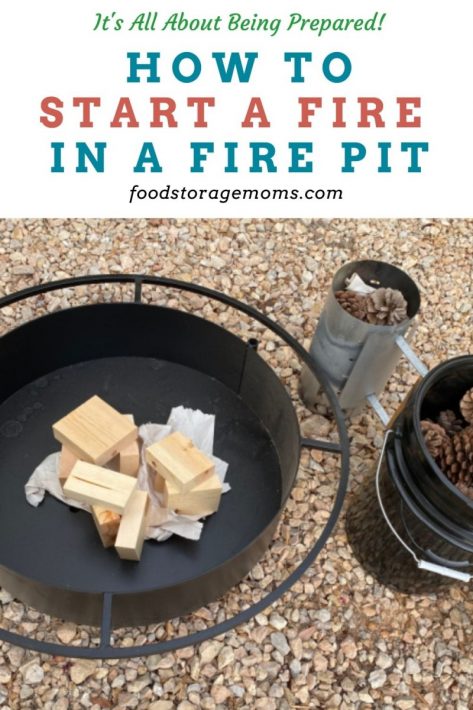
Why Should I Have a Fire Pit?
By the way, I’ve seen the term or word “fire pit” as both two words and one. I decided to use the two-word version for today’s post since it seems to be the most common usage.
Besides being a centerpiece for families during the good times, a fire pit can be the mainstay for your family’s ability to prepare meals and keep warm when a disaster hits. Firepits are a convenient way to cook foods outside if your in-home cooking options aren’t available. An outside fire pit is also a heat source if you’re forced to live or sleep outside for any reason.
Do I Need to Buy a Fire Pit, or Can I Make My Own?
Mark and I bought a metal firepit a few years ago. One of the attractive things about ours is that it’s small enough to move around our yard. We used to have a space in the backyard near our lawn to put it for an evening campfire or family fireside.
We can also put it on some rocks or pavers out front if we have some neighbors over for a fire during Halloween or other cool-temperature holiday get-togethers.
Many families will construct a more permanent fire pit in their yard. You need to find a location that’s not too close to possible fire hazards like a tree, shed, gas line, or even your home.
Fires can send off ashes with the slightest breeze, so be safe when locating and using the firepit.
I’ve seen an outdoor fire pit made of concrete, cinderblocks, bricks, flagstones, and metal to form the fire pit “bowl.” I’m not sure the building material makes a lot of difference. You just need to decide how big you want it and whether you want it lined on the bottom with something like gravel, sand, or pavers. Then, dig your hole and place the firepit rim or sides around the hole to the desired height and thickness.
Most firepits seem circular, but you could make it square or rectangular if that suits you and you have the space you have available.
What Should I Use as Fuel in My Fire Pit?
All fires need fuel to burn. Most backyard fire pits use various types of wood from large bushes or trees. To get the fire in the fire pit to start properly, you’ll need different sizes of wood pieces like small twigs, tree bark, or even dry leaves, and you’ll increase the size as the fire gets bigger to where you’ll use wood logs.
Let’s discuss the terms most frequently used:
Tinder
This fuel is usually tiny, dry, and quick to burn. You should consider gathering some tinder from easy-to-find things like newspapers, pine needles, pine cones, very small tree or bush branches, and even leaves.
This fuel is placed at the bottom of the fire pit and forms the base of the fire. Don’t compact the tinder, it needs air and space so the fire can not only start easily, but also flare up to the next level of fuel, the kindling.
Kindling
This is the fuel that is ignited by the tinder and lasts long enough for larger pieces of wood to burn. The idea is to grow your fire by gradually placing larger pieces of fuel on top of it.
It is best to form a cone, pyramid, or tee-pee-shaped bunch of wood pieces above the tinder in the size most of us call twigs, small tree branches, or dry sticks.
You start the fire by lighting the tinder, which ignites the kindling, which in turn causes larger branches or logs to burst into flame. As mentioned above, placing the kindling is essential so it gets plenty of air, or it won’t burn properly.
Firewood
Why is this fuel often referred to as seasoned firewood? It comprises split logs, large branches, or other larger pieces of wood. The keyword here is “seasoned.”
If you go out in the forest to gather firewood, it is hard to determine how old the wood might be. If you’re allowed to cut live trees, they represent the least seasoned wood available since they are still green.
Seasoned firewood has been given enough time to dry out fully. It should be kept under an overhanging cover or even a waterproof tarp for an extended period so it can dry out completely. The greener the wood the more toxic fumes from smoke you’ll have.
It could take months or even years for the soil to be dry enough to burn efficiently in your fire pit. The goal is a 20% % -30 % moisture content, but who knows how to measure that?
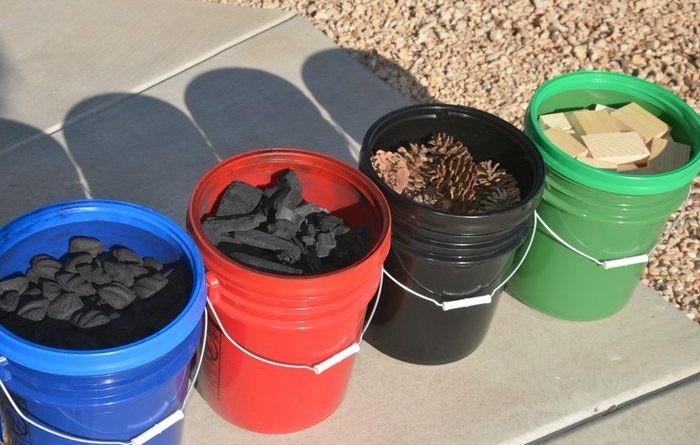
So How Do I Light the Fire in My Fire Pit
You’d think lighting the fire after all this preparation work would be the most straightforward task. That would be the case in a perfect world, but life doesn’t seem to go perfectly when it comes to fires.
You’ll find that wind and moisture are your biggest challenges in getting the fire going.
Mark tells me stories of being in the Boy Scouts and having to start a fire up in the mountains on a campout. Often, mountain breezes came into play, or a late afternoon rainstorm suddenly took the troop by surprise before they could get a fire going.
All Boy or Girl Scouts know we need matches to start a fire outside. Matches are fine, but they don’t put out much of a flame. If your tinder and kindling are small and dry enough, you can make them work.
Otherwise, you’ll need a larger flame, like a cigarette lighter or a butane torch lighter. Strikers are another option, for sure.
We have a bunch of butane torch lighters stored in our kitchen. They mostly work okay, but I wish they were made better to be more reliable. You have to push a button while you flip or roll a switch.
It usually takes me a few minutes to get one to light. Once they do light, the flame is generally sufficient to light the tinder, and away we go. I use one of these, Fire Starter Chimney. In the first picture above and the one below, you can see a circular tube with a handle attached. I call it my fire starter chimney, which has come in handy several times. With the tinder inside, you can more easily start the fire because the chimney helps protect against the wind, and the fire is more concentrated. They work great.
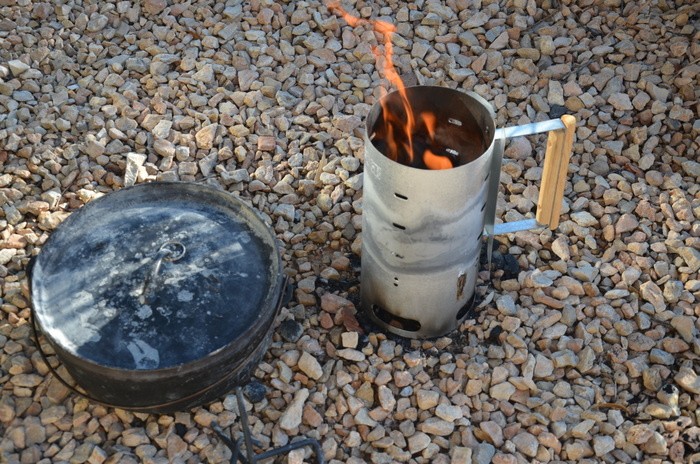
What Are Some Safety Issues When Using a Fire Pit
We discussed the importance of placing the firepit in a location with limited exposure to flammable materials. That also goes for the fuel you plan to burn during your cooking or campfire session. Keep those logs at a safe distance from the firepit itself until you’re ready to use them.
Don’t let the fire get too big, based on the size of the fire pit and what is nearby. Maintaining control is critical. Always have a large bucket or two of water, or even a water hose, close at hand so you can douse the fire if needed.
You’ll also want to extinguish the fire before you retire for the night fully. Don’t get lazy and think the fire will eventually die out and be safe. Use that water, to be sure. Look for any “hotspots” throughout the firepit itself.
Some tools you may want to have available so your fire pit experience goes as planned without any injury to you or a family member include a fire poker, tongs, and fireproof gloves. I’ve even seen people wear goggles, although that may be overkill. Better safe than sorry.
Final Word
Writing about fire pits has been fun and engaging. During my research, I’ve discovered some new ideas about starting a fire in a fire pit. We all enjoy a warm, friendly fire on those cool nights.
A fire pit can be the nucleus of a memorable family or neighborhood activity. The key is to start and maintain a brisk fire properly.
With the information shared today, that should be an easy task for any of my readers. Let’s all keep prepping and make the most of every day. May God bless this world. Linda



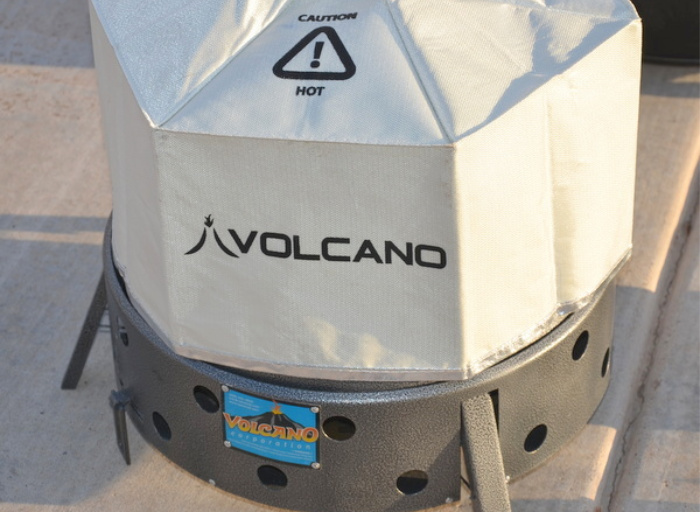
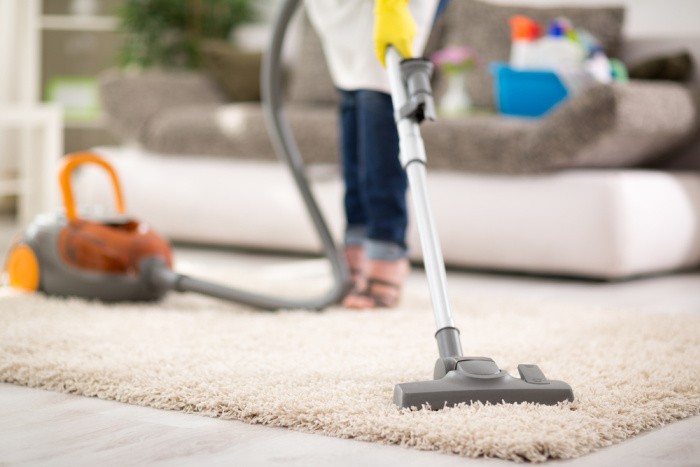
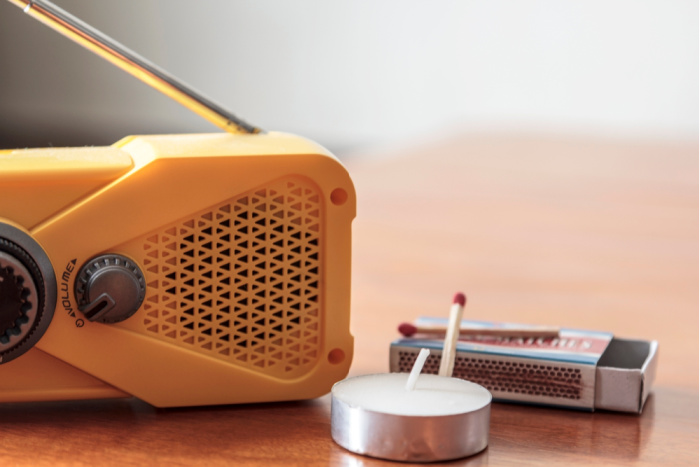
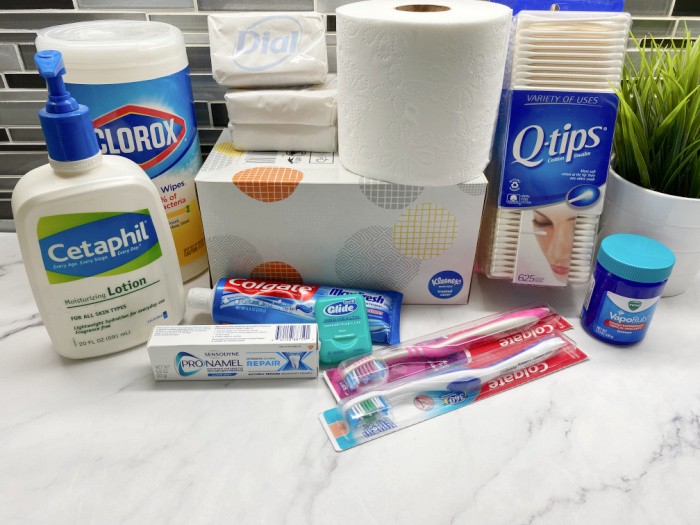
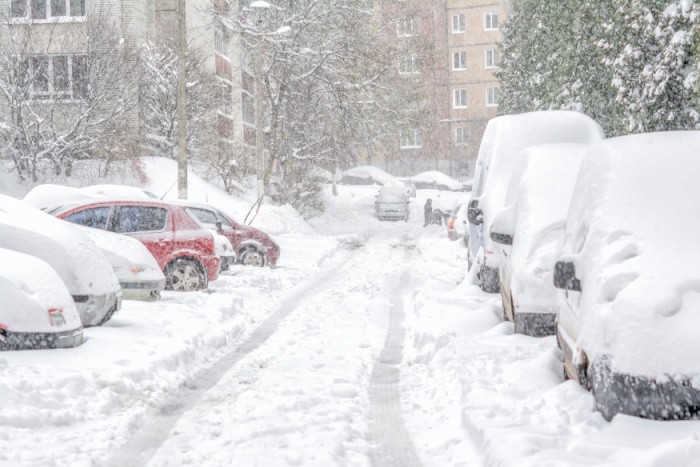
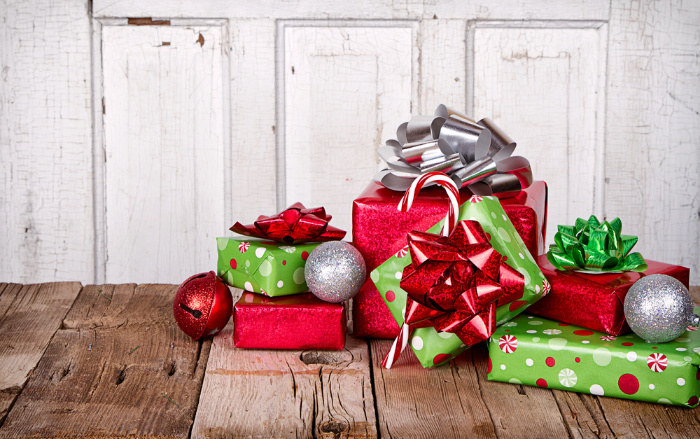













I’m using wood that’s 3-4 yrs old. There’s very little smoke signature. That’s your goal. You won’t have it starting out most likely like any other prep but thats your goal.
If you cut your own wood and as you gain experience you’ll be able to judge moisture content by weight and feel of the wood.
For the pit I prefer good smelling wood like pecan or mulberry.
I build my fire in the pit the same as the fireplace. I leave it set up so if I’m not home the wife can light it and walk away and I know it’ll take.
I use the tepee method with dryer lint and a little cardboard on bottom, then twigs, then sticks.
The twigs and sticks are collected from my yard full of trees before I mow throughout the year and bagged in chicken feed bags. The dryer lint is collected in discarded TP rolls as we do laundry.
I made a tripod to hang a pot from using chain in case I need to cook with it. But mostly it’s recreational. There’s something bout just sitting and feeding a fire that’s calming and even children love.
Hi Matt, oh, I love a good fire pit!! There really is something about sitting around a fire with family and friends. The popping of the fire, the feeling of love shared around the firepit its the best! Linda
I used to convert my greenhouse into a ‘woodshed’ for tinder and kindling …yep, toilet or paper towel rolls filled with dryer lint, small branches, bark pieces that broke off from logs, newspapers twisted, food boxes flattened, cardboard tore into pieces. I’d start filling this tiny (7x7x8) greenhouse the start of August after I’d cleaned it out. Plenty to use for my fire pit and my home fireplace and wood-burning stove thru the fall and winter. Its kinda funny you mentioned the tp rolls with lint as my grandson just asked me where we now keep them as I took down the GH. Yep, he was doing a bonfire. I told him he’d need to grab food boxes from our recycling bin. He kind of forgets that I don’t do even half of what I used to. Maybe he will start doing the things I used to? Peace, Matt
We always hope they do. One of mine has embraced it and the other not so much but she still knows and will when needed
Hi Wendy, this is the best comment!! Linda
I know how to make a fire in a dug out hole in he ground does that count? My husband taught me how to do many things when I was first married. And the things he taught me you never forget.
Hi Jackie, it sure does count, my friend! Memories of what he taught you will always be ready for you to take charge! What a blessing. I went to take pictures last night and couldn’t find any logs to put on top of the wood pieces in the picture. And we were running out of light, so, that’s how I start my fires!! Life is good. Linda
Our son in law is THE master of the firepit. He plans it and monitors it like a mother with a new baby! He will not allow just anything burned. No newspaper or anything with glue or ink. For his birthday we bought him 2 cords of apple wood. An evening at their home with a good fire and good friends, is warming to the body, the heart and the soul.
Hi Chris, oh what a blessing to have someone take charge of the fire pit! Oh my, applewood sounds awesome!! 2 cords of applewood is the best gift ever!! This is the BEST COMMENT EVER!! What an awesome gift! Linda
We supplement our heat in the house with a woodstove. There’s just something sooo much better about woodstove heat! We start off each year with 6 cords of hard wood (usually walnut or oak) but only burn about 2 cords. (I like to be prepared…wink, wink) When we get new wood delivered each spring (too old and broken to cut it anymore ourselves!) it’s green and needs to “season” for a year. We rotate all our wood on the fence under an overhang and with our lean-to areas that are closest to the back door (that snow gets deep!) We still have a firepit in our backyard but with all the fires in Northern California, we haven’t been allowed to burn it for 2 summers now. It’s super windy today, 40+mph winds, so that’s out of the question even tho it’s only 64 degrees today. Besides, as much as I love the smell of wood smoke, I think we’ve had enough of it, especially this summer, to last me quite some time! Reno has been inundated with smoke since July from the Dixie fire and then the Caldor fire! Both are still burning.
One thing I wanted to mention about the pictures you posted – I have always been told to not burn pine cones. They burn real hot, fast and they tend to pop and explode. Maybe they can be good for starting fires but I would never use them inside in my woodstove. We generally stay away from them completely which is too bad because my neighbor’s pine tree pinecones all fall in “my” yard instead of his! I like to buy the firestarters from Home Depot – Rutland, I think it’s called. They come in squares and I usually break them smaller so I can make them last. They’re pretty good.
Hi Robbie, great comment on the pinecones, I only use them for starting a fire in the fire pit and for my Kelly Kettle. You can burn dried leaves, twigs, and pinecones in it. So fuel is basically free. We can’t have any open fire here in Southern Utah for fear of the fires getting out of control. I agree we have all seen too many fires and smoke the last few years. Hopefully, things will calm down and we can get back to normal whatever that else now. Stay safe, stay well, Linda
I’m with Matt, the tipi is my favorite start method too.
I do keep a bucket of pine cones… I can see the argument about not using them inside a woodstove, but outside, they are great. In fact, when I was a kid, my mother used to soak pine cones in various solutions, then dry them out–when put in the fireplace (just one or two), they’d burn in beautiful colors! I should look up what they were soaked in.
Re. matches–yes, even wooden matches can be tricky outdoors. However–if you carefully shave little slivers, leaving them still attached near the head, then once you strike the match, it makes a bigger flame that’s harder to blow out. Same idea as a candle with two wicks a quarter inch apart. Let’s be glad we don’t *have* to use flint and steel–although it’s useful to know!
An old maxim for once the tinder fire is going–“one won’t, two may, three will.” You need at least two sticks of firewood, touching, to keep it burning.
Linda, your article sure brought memories and some new things I do. You mentioned using those long lighters…I too have a problem with them. Um, never used for campfire but my son likes for lighting our propane water heater…I got Long Reach Matches by Diamond for me to use. I bet they’d work great for a fire pit. So, onto memories…I dug out a fire pit almost 20 yrs ago, on 3 sides I put old concrete blocks from a house being torn down. One layer of these blocks above ground. I left the fourth side open to be able to scoop out stuff. I think this fire pit is about 6 ft long, 3 foot wide. We’ve burned any and everything in it except plastics. My youngest boys had ‘camp-outs’ around it in pup tents with their friends near it. Oh, something I always did was to turn on my hose at a trickle (after moistening the ground), for ‘just in case’. Sparks can travel a ways with the slightest breeze. We also kept 2 shovels nearby. It doesn’t take much to get a wildfire in a hayfield.
Hi Wendy, oh my gosh that fire pit sounds awesome. I can almost visualize the boys camping out around it!! How fun! You’re like me, I always have a hose ready to use by the fire pit. I need to get some of those Long Reach Matches by Diamond. Great tip!! Love it! Linda